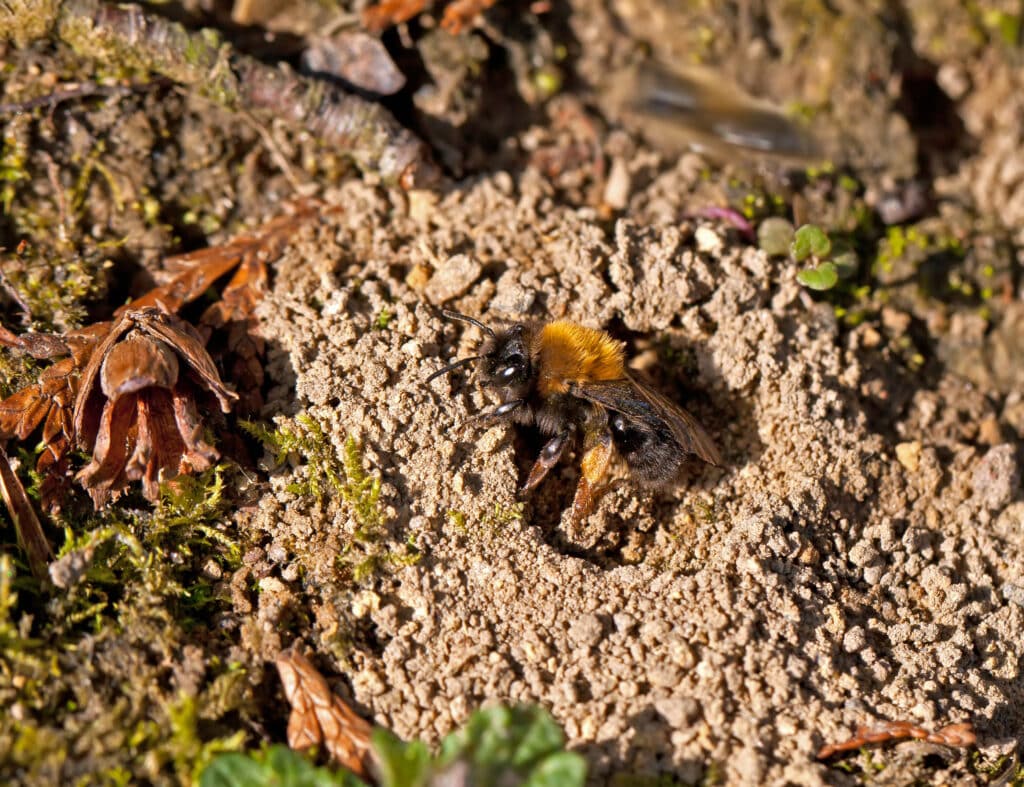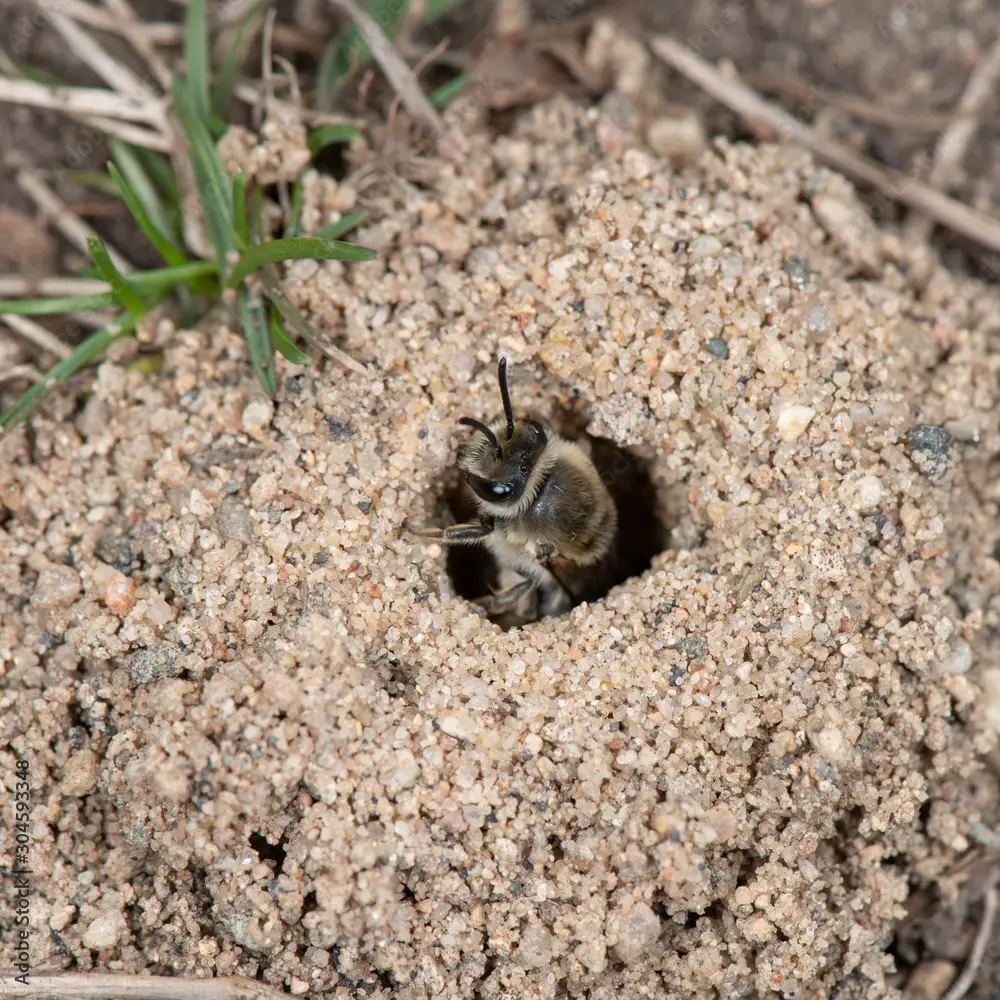Ground bees are a nuisance in every US state. These insects wreak havoc around residential and commercial properties by damaging lawn aesthetics, mounding the soil, and inadvertently causing painful stings.
More than 70% of all native bees burrow into dry soil, meaning most stinging insects come from the ground up. This may take a toll on your yard by damaging healthy grass or leaving piles of dirt around your property.
Thankfully, there are many options for removing ground bees naturally, chemically, or through DIY methodologies.
Here’s everything you should know about the ground bee removal process, including common burrowing bee species, nest identification steps, and ways to get rid of ground bees before taking over your yard.
What Are Ground Bees?
Ground nesting bees live in small underground tunnels near loose soil or shady areas. Unlike yellow jackets, these pests live alone and do not function in large colonies. They also don’t produce any honey, although they pollinate plants in their quest for food.
Female ground bees lay eggs during the fall and emerge in early spring, then busy themselves with pollinating 80% of the world’s flowering plants.
Ground bees are attracted by various substances, including fruit juice, flowers, or even human sweat. Once they’ve established a burrow on your property, they will reappear every spring for at least three to four weeks.
Burrowing bees are sometimes referred to as mining bees or digger bees, although these are umbrella terms referring to multiple species. Common ground bees to know include:
- Mason bees
- Bumblebees
- Sweat bees
- Leaf cutter bees
- Plasterer bees
Most ground bees are non-aggressive and prefer to fly rather than fight. However, female ground bees sting when attacked or threatened. This may cause an allergic reaction or anaphylactic episode in at-risk persons, which is why proper identification and maintenance is imperative to ongoing safety.
Ground Bees Identification
Ground bees have several physical variations, unlike honey bees, carpenter bees, and yellow jackets.
Most ground bees are tan and black and rarely grow much larger than European honey bees. You’ll notice that many species have thick bristles and appear fuzzy or have a metallic sheen and uncharacteristically bright stripes.
Ground Bee Nests – What to Look For
A ground bee nest can be hard to spot without previous experience. In general, you should keep an eye out for:
- Loose soil
- 1/4-inch holes in the ground
- Mounds of dirt
Watch for any female bees flying in or out of entry holes. This is a sure sign of an active ground bee nest in action.


How to Get Rid of Ground Bees
Ground bees are not necessarily dangerous insects, but higher than average populations should be contained as soon as possible.
Here are some simple ways to eliminate ground bees using chemical or natural approaches.
Chemicals
Professional treatments kill bees much faster than natural methods.
A substance like Permethrin kills ground bees within minutes. Liquid forms can be applied directly to tunnel entrances, while Permethrin granules can be broadcasted where entry identification is more difficult.
Products like Orthene 97 Spray Insecticide can also get rid of ground bee burrows. Early application will prevent bee stings in advance by pushing pollinators toward natural spaces.
Remember that bees are not the only pests affected by chemical treatments. Over-the-counter products often impact other lawn pests, so you should consider where and how much is applied at once.
As always, be sure to wear protective clothing while applying chemicals to your yard. This protects your skin from reactive substances and also wards off bee stings.
Natural Methods
You have several pest control options to choose from:
- Sprinkle coffee grounds or cinnamon powder around identified ground bee nests. This is a great way to naturally control pollinator populations without making the bees die.
- Use vinegar spray on dry soil to discourage nesting. Keep in mind that if you apply vinegar directly to the bees, it will kill them.
- Drive ground bees toward different habitats by attracting natural predators (ground spiders, dragonflies, etc.). This is a humane method of pest control that discourages re-infestation without affecting endangered pollinators.
You could also repel ground bees naturally using water mixed with cinnamon powder, baby shampoo, or cucumber peels. This creates a strong odor that’s very unpleasant to bees while simultaneously wetting the soil, which discourages continuous nesting.
Remember: bees are critical to a thriving ecosystem. The pest control methods you choose should be geared more towards controlling rather than killing ground bees.
Ground Bees FAQs
Homeowners have many questions related to ground bee control, particularly when their eggs hatch in early spring.
Kick-start some proactive prevention with the answers to these frequently asked questions.
How long do ground bees stay in your yard?
Ground bees, digger bees, and mining bees reuse the same tunnels year after year. This means they can stay in your yard indefinitely, even for decades on end.
Ground bee infestations will rarely abate on their own. For this reason, it’s best to address any infestations right from the get-go with DIY pest control solutions.
Will vinegar kill ground bees?
Vinegar will kill ground bees upon application.
If you’d rather dissuade ground bees than kill them, it may be worth investigating less lethal deterrence methods.
How do I get rid of bees in my grass?
Water is one of the most efficient ways to eliminate ground bee nests in your grass. You can manually apply water using a hose or spray bottle if you don’t have a sprinkler system. Note that this method could take several weeks to produce results.
What will deter ground bees?
Different species of mining bees respond to different repellents.
Common ways to repel bees include:
- Equal parts cayenne pepper and water in a spray bottle. This is an excellent eco-friendly bee repellent.
- Ground cinnamon around the entrances of an underground nest. You can also stick cinnamon sticks directly into the holes to prevent ground bees from returning yearly. Substances like cayenne pepper are equally efficient.
- Covering nest holes with a heavy object (i.e., bricks or stones). Note that persons with bee allergies should not attempt this method.
Don’t forget to attract natural bee predators to your yard. This will keep bee populations from growing out of hand and support a healthier ecosystem.
